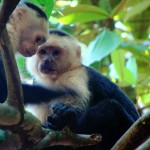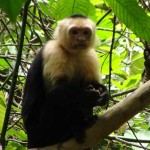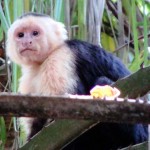Capuchin Capers
The troop of 28 monkeys was strung out over about 100 meters, moving through the forest. The lead monkey, a mature female, came to an area where the tree cover was broken by an open swamp with only a narrow corridor two trees wide going around it. About half way across the corridor the leader abruptly leapt back and let out an excited yelp, one of several different alarm barks the two observers had heard them use. This initial bark was followed by a series of short barks in a slightly calmer voice. Flor Vallet scanned the foliage with her binoculars near where the lead monkey had been when when it jumped back. Finally she saw the source of alarm, a non venomous bird-eating snake. It wasn’t large enough to harm a full grown monkey, or even a juvenile, but it was a snake nevertheless, and they instinctively disliked it. The troop kept moving forward, but as they arrived at the point where the snake was coiled each monkey veered over into a neighboring tree, staying well out of its reach. They didn’t need any further signals. Every monkey in the troop knew exactly where the snake was coiled. Was this communicated to them via the alarm call followed by the short series of barks emitted by the lead monkey when it first saw the snake?
When Florence Vallet and Hannah Wilkins set out to learn more about the monkeys of Hacienda Barú, this was not a question they thought they would be answering. Their objective was merely to determine how many troops of white-faced capuchin monkeys (Cebus capucinus) there are on Hacienda Barú National Wildlife Refuge, how many monkeys in each troop, and to identify the individuals of one or two of the troops. The next step was to observe the behavior of the monkeys, photograph them and take notes. After a little over a month the two young naturalists have already answered the basic questions and have observed some amazing behavior that seems to suggest answers to the question posed above and others. Not only that, but they have become totally enthralled by the capers of these fascinating capuchin monkeys with the white faces. As a matter of fact they have become self proclaimed capuchinophiles.
Flor Vallet is no stranger to capuchin monkeys, the most intelligent genus of new world monkeys. They are so intelligent that they have been called the “New World Chimpanzees,” by the authors of the book, The Complete Capuchin. Flor’s introduction to capuchin monkeys came in 2001 when she worked at the La vallée des singes zoo near Poitiers, France. In 2005 she came to Costa Rica and worked as a volunteer at the Curú National Wildlife Refuge in Nicoya, where she again had considerable exposure to these amazing primates. She has been at Hacienda Barú since 2007 volunteering as an interpreter with French speaking visitors. Now Flor is doing what she likes best, following the capuchin monkeys, observing their behavior and trying to learn as much as possible about them.
Flor’s assistant, Hannah Wilkins, hails from North Port, Florida where she recently graduated from Venice High School. During her high school career Hannah had a zoology class where your author’s book, Monkeys Are Made of Chocolate, was required reading. Later her class took a trip to Costa Rica, visited Hacienda Barú and met Jack. That was when she decided she wanted to come here as a volunteer. After a month working with Flor, soft spoken Hannah is as totally dedicated to learning about capuchin behavior as her mentor.
When they began the project, Flor thought there were only two troops of white-faced capuchin monkeys on Hacienda Barú National Wildlife Refuge. To her delight, to date she and Hannah have identified seven distinct troops, ranging from 14 to 28 individuals. Of these troops, they have selected the Mancha Negra (black spot) troop and the Muñeco (named after their favorite fruit tree) troop for more intensive study. Mancha Negra tends to spend most of its time in the forests near Hacienda Barú Lodge, and the members are accustomed to seeing humans on the walking trails. The principle mature males in the group are “El Padrino, Darko, Scar Face” and “Bubba,” with the former being the dominant male.
One particularly hot day around noon, part of the Mancha Negra group were on the ground near a stream. They were lazily foraging along the forest floor when Bubba walked into the stream. He wandered around in the water until he found a hole about a foot deep. Standing in the middle of the hole, Bubba squatted down until the waterline was all the way up to his neck. He just sat there, with only his head sticking out, for about 30 seconds, then stood up and walked out of the stream. He made no effort to shake the water off or in any way dry himself. While in the water he gave no indication that he was trying to clean himself, and Flor and Hannah are convinced that he only wanted to cool off. The girls have observed this behavior on three different occasions. Every observation of monkey baths took place near midday on a hot day, and only mature males dipped their bodies into the water. To date, this behavior has been observed only with the Mancha Negra troop. Flor never observed this at the zoo in France nor at the Curu Reserve in Nicoya, Costa Rica. It is not reported in The Complete Capuchin.
Do the males in all of the troops cool off in the streams or is this behavior particular to the Mancha Negra troop? Do the females do the same, or the males of other troops? Are there significant behavioral differences between the Hacienda Barú capuchins and those of other places? To what extent do monkeys communicate with each other? How complex is their verbal communication? These are a few of the questions that will be on the two girls minds as they follow the troops of capuchins around Hacienda Barú and observe their day to day activity.
The Strange Relationship Between Capuchins and Coatis
Hacienda Barú guide Juan Ramón Segura stood with several visitors watching a group of white-faced capuchin monkeys in a strangler fig tree replete with ripe fruit. The primates were pulling handfuls of figs from the branches, stuffing as many as possible in their mouths and dropping more than they ate on the ground. There was a lone male coati (Nasua narica) in the tree as well, delightfully helping himself to the small, round, red fruits, picking the figs one or two at a time, chewing and relishing the flavor and then picking another. In the upper branches were a pair of chestnut-mandibled toucans (Ramphastos swainsonii) snapping figs off the branches, tossing them into the air and catching them in over-sized beaks. A careful look revealed a number of smaller birds, tanagers, euphonias and vireos feeding within the foliage in the middle of the tree. The strangler fig tree that afternoon was a veritable delicatessen for half a dozen different species.
Juan was answering a visitor’s question when a noisy commotion erupted over to one side of the fig tree. The coati with teeth bared, was huddled back into the branches. He was surrounded by four or five monkeys. The capuchins were barking and screaming at the coati, obviously furious about something. One made a move to his front side reaching almost to the coati´s long, pointed snout with its hand. When the raccoon-like coati lunged toward the monkey, two more of the gang grabbed him from behind, and the rest moved in quickly and subdued the furious mammal. The capuchins didn’t waste any time with the coati. From Juan’s point of view it looked like they gave a mighty heave and hurled him out of the tree. Fortunately the coati’s fall was broken by a couple of branches as he plummeted to the ground, about 10 meters (33 feet) beneath. He suffered no serious injuries, only a good shaking up.
This incident illustrates how these two species can be happily feeding together one minute and turn violent the next. In this encounter it is not clear what triggered the monkeys to attack the coati, but Juan has the idea that the coati didn’t do anything to evoke their anger. It was almost like a bunch of teenage boys ganging up on a classmate. Many of the guides have seen white-faced capuchin monkeys harass lone coatis, but none of these encounters have resulted in actual physical contact. Almost anyone who lives on Hacienda Barú has seen the two species contentedly sharing a meal together, whether it be figs, palm flowers or cecropia seeds.
Though four or five monkeys were able to throw an adult male coati out of a tree, they had a serious struggle on their hands. I doubt if they would have tried it with a gang of only two or three. A coati’s teeth and claws are sharp and they can be very nasty. No monkey is about to tangle with one unless the odds are greatly in its favor. This is not the case, however, with infants. In fact, white-faced capuchin monkeys, which are omnivorous, are the most serious predators of baby coatis. Female coatis make nests, similar to squirrel nests, in the tops of trees. There they give birth and care for the helpless young until they are able to travel with the group. The adult females and young travel in groups that sometimes surpass twenty in number. This provides a high degree of protection. In the nest it is a different story. There the infant coatis are vulnerable, and the capuchins take advantage of the situation. If a group of monkeys can locate a coati nest, it is a fairly simple task to slip in, snatch the baby coatis and scamper away before mama coati comes back.
At one time in the tropical dry forests of Guanacaste province, biologists feared that the capuchins would drive the coatis to local extinction. Normally coatis give birth during the dry season when the weather is favorable, but food is scarce. When there were almost none of the species left in the Guanacaste dry forests, the few remaining females, started giving birth during the rainy season, when the monkeys have plenty to eat. With full stomachs, the capuchins didn’t put nearly as much effort into searching out and raiding the coati nests. Coati numbers have increased significantly, and after several years, local extinction was no longer a concern.
One day in October of this year Florence and Hannah were observing the Mancha Negra troop of white-faced capuchins in the lowlands of Hacienda Barú National Wildlife Refuge. It was near mid-day, and the troop just hanging out, not doing much of anything. They were scattered around in the tops of several different trees, some lying on the branches with arms and legs dangling over the sides, one resting in the crouch of a tree, two females were engaged in mutual grooming, and a few of the young were half-heartily playing among the branches. A lone coati male rested on a branch, near the monkeys, but a little off to one side.
A juvenile capuchin gingerly eased up to the coati, but stopped one step short. The raccoon-like male didn’t so much as glance at the young monkey. After a few minutes the juvenile eased up to the coati and again sat attentively observing, but the big male remained oblivious. Finally the youngster reached out and touched the thick fur on the coati’s back, stroking gently in a grooming motion. When the coati still didn’t react, the monkey confidently continued to groom the other mammal just like he might groom his mother or one of his fellow juveniles.
Flor was amazed. It was the first time she had observed or even heard or read of grooming behavior taking place between capuchins and another mammal of a different species. After a short while the strange behavior attracted the attention of El Padrino, who walked right up and stood over the juvenile, completely covering it with his head, shoulders and chest. Undaunted the smaller monkey continued grooming the coati, which hadn’t moved and seemed quite contented to be groomed by the primate. El padrino watched for a minute, and then he reached out and began grooming the coati along with the juvenile. The two continued their strange grooming behavior for about a minute. Apparently bored with the novel activity, El Padrino walked away and the juvenile followed.
This experience serves to illustrate just how complex the relationship between these two species is, ranging from infanticide to one-sided grooming, from extreme violence to affectionate behavior. Florence Vallet feels that much has to do with the capuchin’s mood. When they are active and full of energy, they are more inclined to mischief. At siesta time, they are more likely to be cordial. As Flor and Hannah continue their observations of these fascinating primates, they hope to shed a little more light on the strange relationship between capuchins and coatis, as well as many other questions.




